
Rattan vs Cane: Which is Better for Outdoor Furniture?
When creating the perfect outdoor space, choosing the right materials for your outdoor furniture is crucial to ensure they can last all year round.
And when it comes down to materials, two options often come to mind: rattan and cane.
Many assume that rattan and cane are the same material, given that they come from the same plant. At a glance, they both appear similar in terms of design styles, finish, and tones. But, contrary to popular belief, they are slightly different materials and used in different ways.
In this article, we explore the key differences between rattan and cane, their benefits, and help you make an informed decision on the ideal material for your outdoor furniture.
What is rattan?
Rattan is a natural material derived from the rattan palm, a type of climbing plant primarily found in tropical regions of Southeast Asia. Its popularity in outdoor furniture stems from its exceptional durability and timeless beauty.

The Mico Rattan Armchair and Stool that gives off a tropical vibe.
Rattan also boasts a rich texture, unique natural grain, and a scent that gives a tropical feeling. It's natural appearance and light woody tones complement various design styles, adding an eminent of nature to the space.
Benefits of rattan
Durability
Rattan is known for its ability to withstand the elements and still retain its beauty even after prolonged use. Its natural fibers are strong and moisture-resistant, making it a reliable choice for outdoor furniture construction.
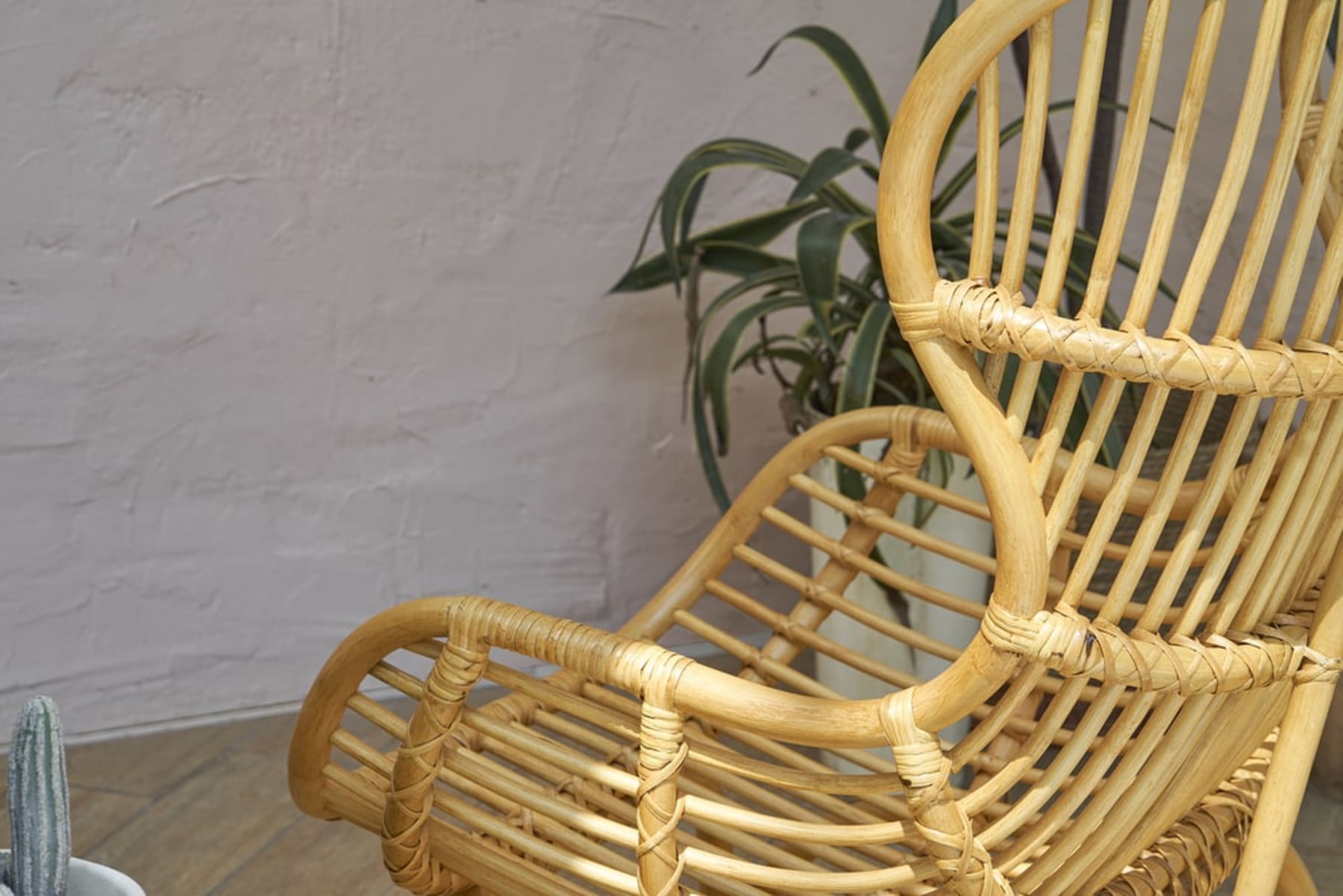
Rattan’s natural fibers are strong and durable.
Flexibility
Rattan's natural flexibility allows for intricate weaving and designs. This flexibility makes it a preferred choice for creating woven patterns in furniture, such as chairs, sofas, and tables. The pliability of rattan can add an elegant touch to your living spaces.
Lightweight
Despite its strength, rattan is relatively lightweight. This characteristic makes it easy to move and rearrange rattan furniture in your outdoor space.
Maintenance
Rattan furniture is relatively low maintenance and doesn’t require special care. Regular cleaning to remove dust, keeping it away from direct sunlight, and ensuring the rattan furniture is dry can help preserve its appearance and extend its lifespan.
What is cane?
Cane refers to a specific part of a rattan palm, specifically the outer bark of the rattan vine. Rattan palms are known for their slender, flexible stems, which are used to create cane.
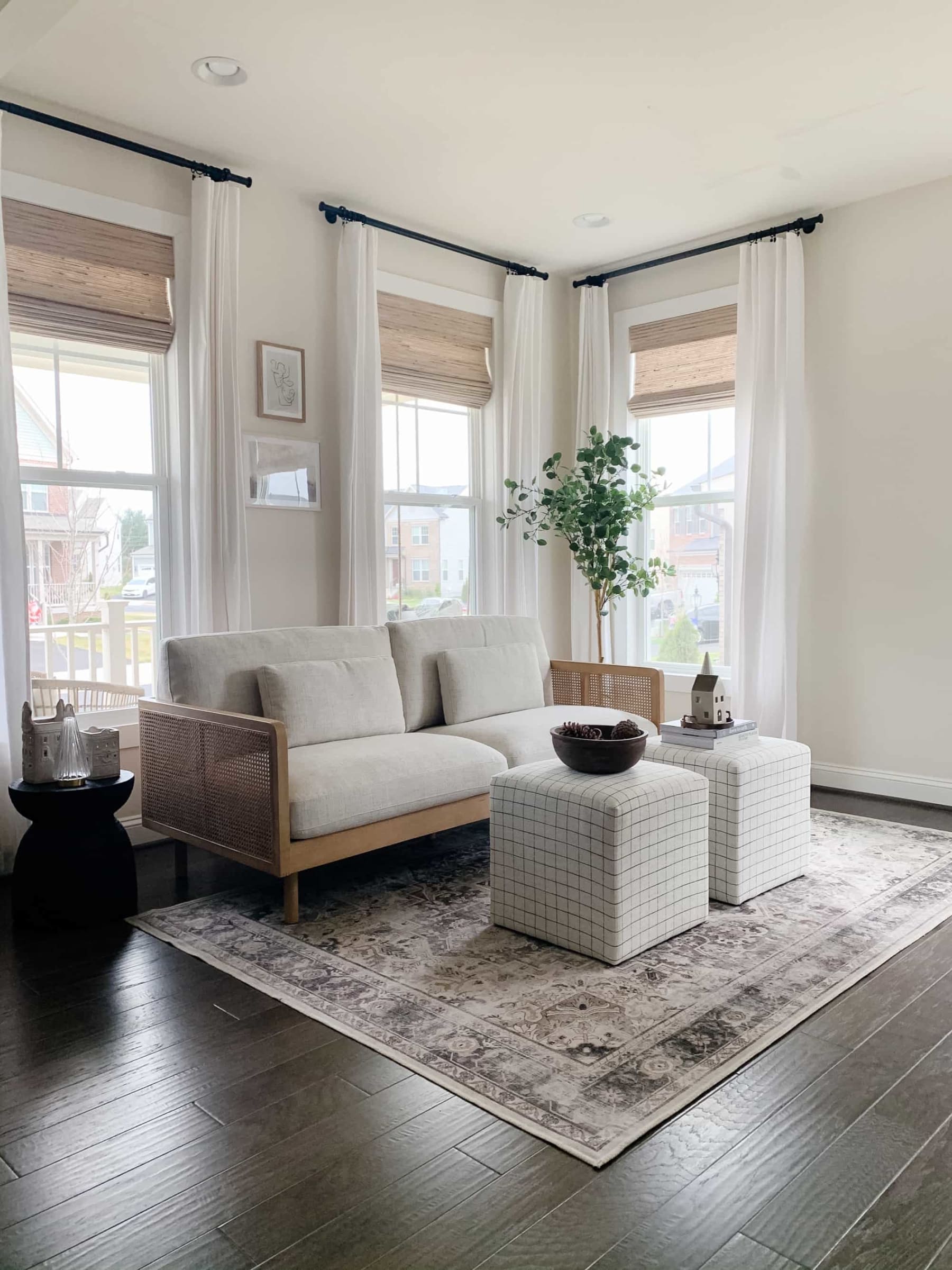
@chalovescafe keeps the lounge clean and classy with the plush Lucia Cane Sofa taking center stage in a contemporary white-themed living room.
One of the key features of cane is its distinctive woven pattern. The intricate, open weave of cane adds an elegant and classic touch to furniture and decor. The natural color of cane, which is typically light or honey-colored, complements various design styles.
Benefits of cane
Versatility
Cane is commonly used in furniture construction, particularly in creating chair seats and backs. It is often woven or laced onto a frame to form a comfortable and supportive seating surface. Cane can also be found in decorative elements, such as cabinet panels, headboards, and room dividers.
Comfort
Cane seats and backs are known for their comfort. As they are slightly flexible, the cane weave offers support for chairs and other types of seating. Cane seats are often favored for their ergonomic properties when compared to other 'wooden' seating.
Durability
Cane is a strong and resilient material. When properly maintained, it can withstand the weight and regular use associated with seating. However, it's important to note that cane can be susceptible to damage from moisture and excess weight, so it's crucial to care for it appropriately.
Maintenance
Like rattan, cane is relatively low maintenance. But, aside from the occasional dusting and wiping, applying a thin coat of oil or varnish can prevent the cane from drying out or cracking.
Rattan vs cane vs wicker
Wicker is often added to the mix and associated with rattan and cane. In actual fact, wicker refers to the weaving technique used to create furniture rather than a specific material.
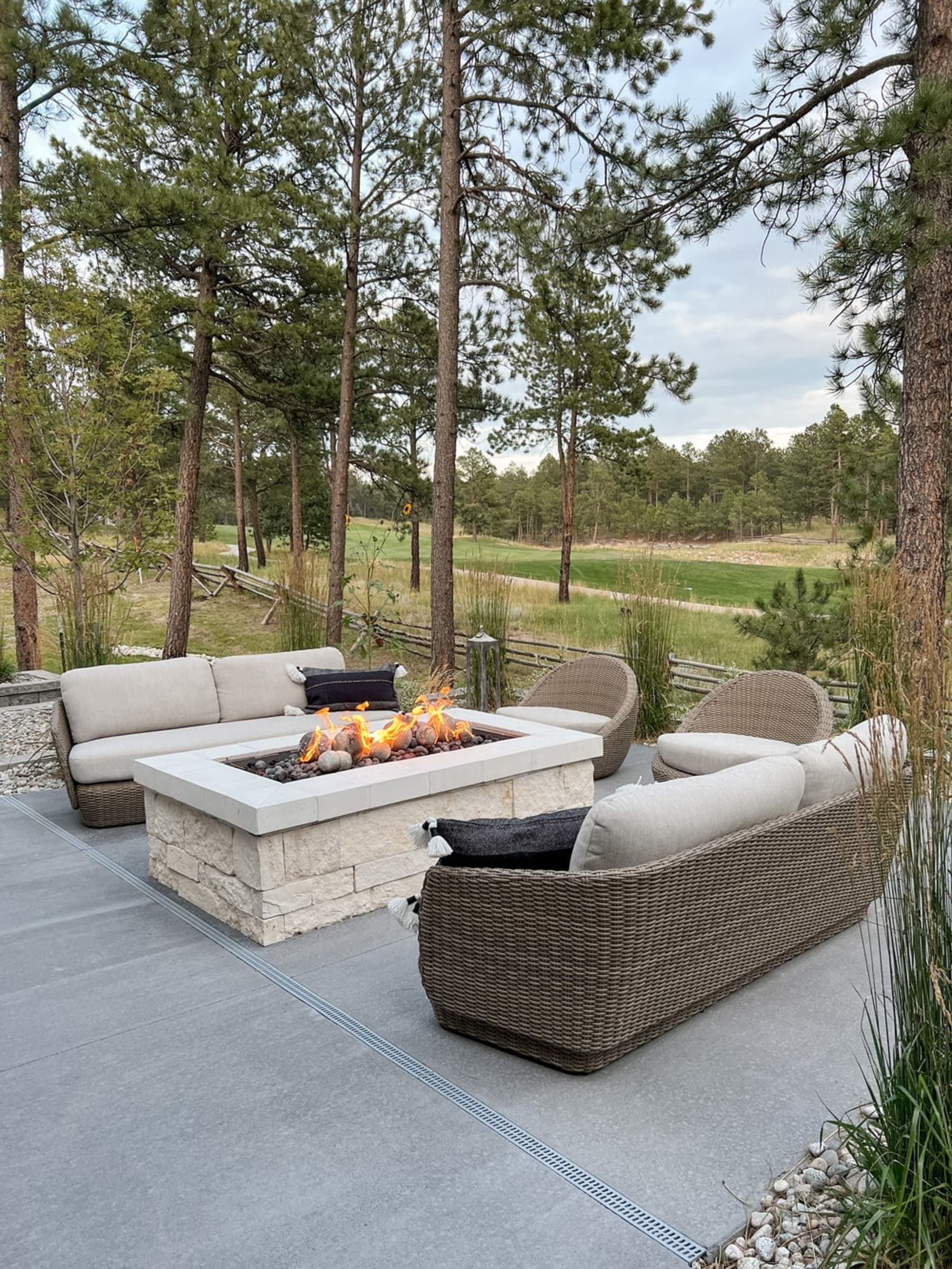
@misaliddiard creates a calming sanctuary in her backyard with the Malta Outdoor Sofas and Lounge Chairs.
Wicker involves weaving slender, pliable materials together to create furniture. While the term "wicker" is often associated with natural materials like rattan, it can also crafted from a variety of materials like bamboo, willow, reed, and even synthetic fibers like resin and vinyl.
Common wicker materials
Rattan wicker
Rattan (or cane) is one of the most common materials used for wicker furniture due to its durability and flexibility. Rattan and cane wicker is crafted from the stems of the rattan palm plant, which are split into thin strips and then woven together.
Bamboo wicker
Bamboo is another natural material used for wicker furniture. Bamboo wicker is created by splitting bamboo stalks into strips and weaving them together. It offers a distinct appearance and is often used for lightweight, casual furniture.
Synthetic wicker
Synthetic wicker is made from materials such as polyethylene or resin. It is designed to mimic the look and feel of natural wicker but offers enhanced durability and resistance to the elements. Synthetic wicker is a popular choice for outdoor furniture due to its weather-resistant and long-lasting properties.
The differences between cane and rattan
While both materials come from the same plant, they are often used in different ways and for different purposes.
Generally, rattan is used in the construction of entire pieces of furniture, such as the Mico Rattan Armchair or Mico Rattan Coffee Table.
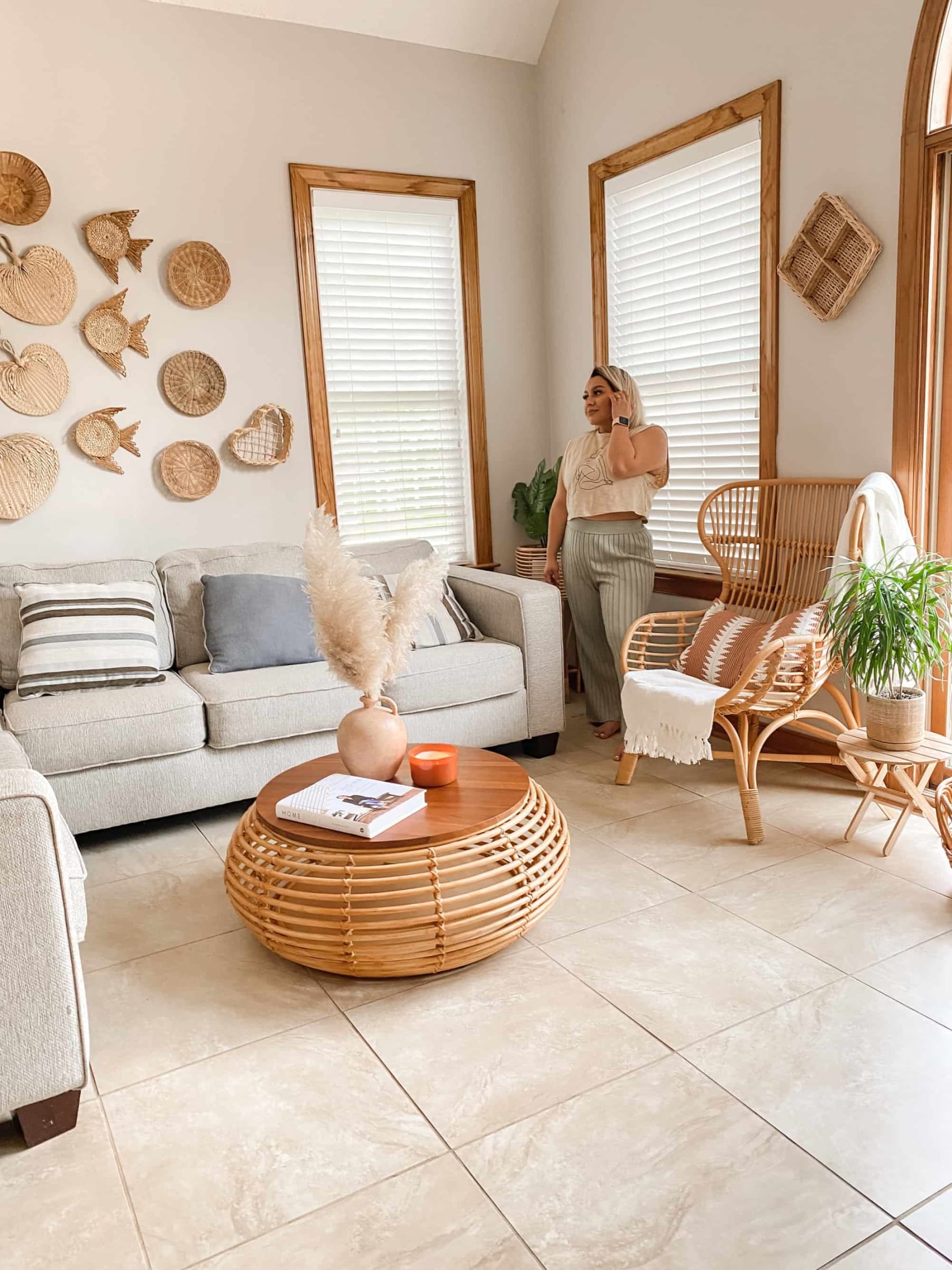
Elevate your living room and bring in the vibes of a boho-chic resort with rattan curves from the Mico Rattan Coffee Table and Mico Rattan Armchair. Picture credit: @deysislife
Being a natural material, rattan can be used in various room styles, including boho, retro, or coastal. Be mindful that rattan is porous, so it can get damaged if exposed to moisture or kept in humid conditions.
On the other hand, as mentioned earlier, cane is often used as frameworks or accents with wood-, rattan-, or metal furniture. The use of mixed materials elevates the sophistication of the furniture and you can find such combinations in chairs, sofas, or storage pieces. Cane weaves add a natural accent to any furniture piece, creating a relaxed and inviting vibe.
Can you use rattan or cane furniture outdoors?
Both rattan and cane furniture are excellent materials for outdoor use - which is why you can find several outdoor furniture constructed with these two materials. But, to ensure they withstand the test of time, it's always a good idea to use furniture covers to protect the rattan or cane furniture from the elements.
Try to avoid extensive exposure to moisture for rattan as this can cause some warping, discoloration, and degradation over time. Cane is slightly more resilient but also needs to be treated carefully if used outside. Of course, it is also possible to get certain types of polyrattan that are specifically designed for outside use.
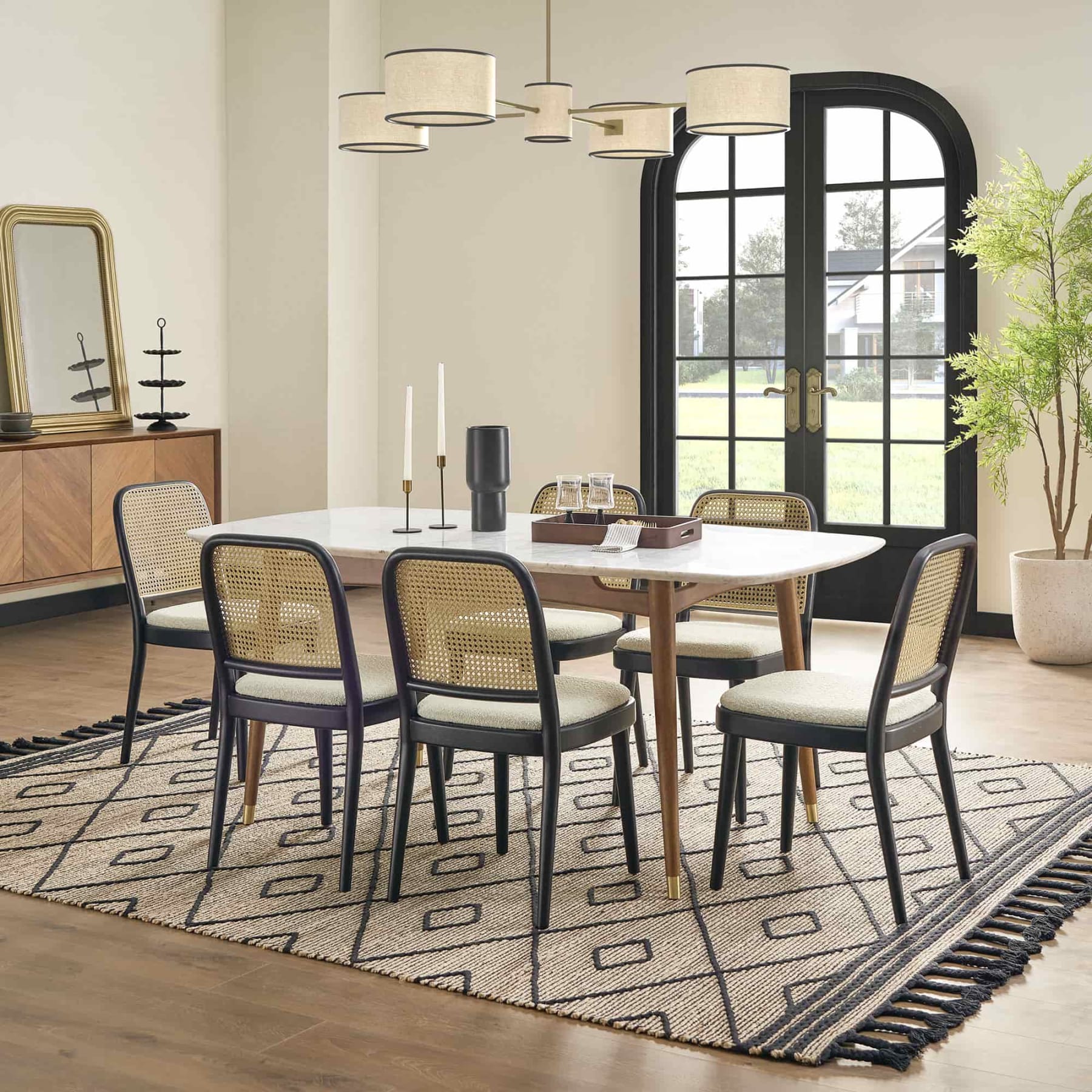
The Edith Cane Chairs make the dining room (styled with the Ventura Jute Area Rug and Kesley Marble Dining Table) feel like a café with its cane backrest and bouclé seat encased in a black frame.
Maintaining rattan and cane furniture
The key to long-lasting furniture is regular maintenance! Even if the materials are 'low-maintenance', this doesn't mean no maintenance. This is even more important for outdoor furniture, as they have to battle the rain and sun.
Regular dusting: Regular dusting is vital to prevent the accumulation of dirt and dust in the weaves of rattan and cane furniture. Use a soft cloth or brush to gently remove surface dust. This simple routine maintains the furniture's pristine look and prevents build-up.
Cleaning with a damp cloth: For deeper cleaning, use a slightly damp cloth. Gently wipe the surfaces of your furniture to remove any stuck-on dirt or spills. This method is particularly effective for cane furniture, which may have more intricate weaves.
Protecting from extreme weather: To preserve the natural color and integrity of rattan and cane, avoid prolonged exposure to direct sunlight and extreme weather conditions. Use furniture covers or place them under shelter to extend their lifespan.
Occasional waxing for rattan: Light waxing of rattan furniture can help retain its luster and protect the wood. This can be done periodically to keep the furniture looking fresh and new.
Misting cane furniture: Cane material can benefit from occasional misting with water. This prevents it from drying out and cracking, ensuring the cane remains pliable and strong.
Which is better: Rattan vs cane
Now that you have a better understanding of both materials, which is better for outdoor use?
Ultimately, the choice between rattan and cane depends on your specific needs and preferences. Rattan offers exceptional durability, versatility, and natural beauty, while cane provides timeless elegance and comfort. For the best of both worlds, get furniture pieces that combine rattan frames and cane weaves.
Whether you opt for rattan or cane, both materials can enhance the charm and comfort of your outdoor space. With the right care and consideration, your outdoor furniture can become a lasting addition to your home, providing a welcoming retreat for years to come. So, take your time, weigh your options, and create an outdoor oasis that reflects your unique style and needs.
FAQs
Is wicker stronger than rattan and cane?
Comparing wicker to rattan or cane is heavily material dependent. As one is a type of weave used in furniture construction, and the other is a natural material, the basis for comparison here is the type of wicker material. For example, synthetic wicker - made from materials like polyethylene or resin - offers enhanced durability and resistance to the elements. This makes synthetic wicker stronger when compared to rattan or cane.
Can I use rattan or cane furniture indoors?
Yes, rattan and cane furniture are suitable for indoor use, where they are less exposed to moisture and UV rays. They can add a warm touch to your interior decor.
Can I mix natural and synthetic materials in my outdoor furniture?
Yes, some outdoor furniture combines natural frames (such as rattan or cane) with synthetic wicker, offering a blend of aesthetics and durability.